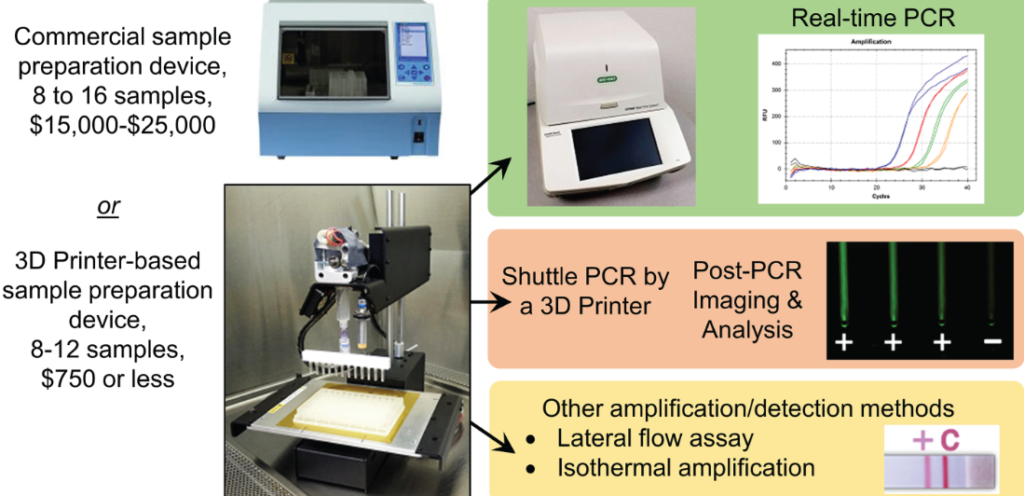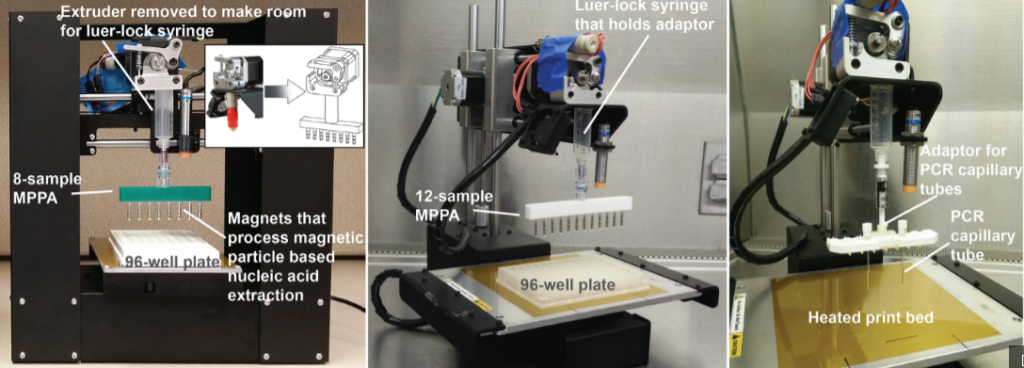Al Biosciences Researchers Modify Printrbot 3D Printers for Detecting Diseases Quickly, Affordably, Easily
 While suddenly it may seem that you run into 3D printers everywhere, from shopping at Sam’s Club to stumbling onto a fully decked out 3D printing lab at your neighborhood library, and suddenly one out-of-this-world innovation after another is cropping up, from off-the-grid houses to 3D printed music, the realm is still quite uncharted for many, especially in labs around the world. And while some of the very tangible creations we are seeing today are very useful as well as fun, it’s scientists who often show us the true potential for changing the world as we know it—and then becomes especially interesting when it’s in regards to our health and saving lives.
While suddenly it may seem that you run into 3D printers everywhere, from shopping at Sam’s Club to stumbling onto a fully decked out 3D printing lab at your neighborhood library, and suddenly one out-of-this-world innovation after another is cropping up, from off-the-grid houses to 3D printed music, the realm is still quite uncharted for many, especially in labs around the world. And while some of the very tangible creations we are seeing today are very useful as well as fun, it’s scientists who often show us the true potential for changing the world as we know it—and then becomes especially interesting when it’s in regards to our health and saving lives.
Coming up with a concept in the lab isn’t always enough though. A lack of tools can be a true obstacle, but that did not stop a group of bio-scientists at Al Biosciences, in College Station, Texas. At this early-stage company, they work to design a range of affordable, user friendly diagnostics. But in a recent and truly groundbreaking project, they’ve now modified their own Printrbot 3D printer to also help in detecting diseases.
Just published recently in the PLOS journal, scientists Kamfai Chan, Mauricio Coen, Justin Hardick, Charlotte A. Gaydos, Kah-Yat Wong, Clayton Smith, Scott A. Wilson, Siva Praneeth Vayugundla, and Season Wong outlined their findings in ‘Low-Cost 3D Printers Enable High-Quality and Automated Sample Preparation and Molecular Detection.’ Their goal was, quite simply, to find a way to bring molecular diagnostic methods down to earth. Currently this type of work requires users who have extensive training and then, the systems required to perform related tasks are traditionally very expensive.
“Although nucleic acid (NA) purification kits and instruments are available from companies such as Invitrogen, bioMerieux, Roche, and Qiagen, these existing instruments range in cost from $15k-$80k,” state the scientists in their paper. “While manually operated sample preparation methods are also available, they are labor intensive and susceptible to contamination, handling variations, or user errors.”
Working to make the tools easier to use and affordable at point of care (a specialty at Al Biosciences), as well as ‘low-resource settings,’ the researchers began considering what they could do with a 3D printer, with the hopes of ultimately helping to solve health problems around the world through the two main elements so many within the 3D printing industry also commonly mention: accessibility and affordability.
“A simple, low-cost alternative to conventional lab-based equipment would greatly reduce the barriers to providing modern medical diagnostics to low- and middle-income countries,” state the researchers in their paper.
And with that idea, they modified the Printrbot for making a preparation device through a magnetic particle (MP) based nucleic acid (NA) isolation and purification approach. As for the printer itself, the research team also showed how it can work as a platform with additional NA amplification capability. They found that they could indeed make it perform as an NA extraction device providing ‘highly purified DNA/RN’ for analysis, along with performing simple assays.
In modifying the Printrbot for affordable diagnosis of infectious diseases, the research team found some major benefits, to include:
- Higher speed in automated extraction
- Minimal user intervention required during the process
- Reduced performance variations caused by users
- Compactness of equipment allows for ease in lab
It’s also interesting to note that the research team used four different 3D printers initially, and then settled on the use of both the Printrbot Play and the Printrbot Simple. A major part of the modification included switching out the extruder for a magnetic particle processor attachment (MPPA). The extruder that they removed was then put into use as a heater for both elution and isothermal amplication.
They also had to work from the software end:
“We repurposed the 3D printer for NA extraction by writing G-codes to control the motion and many other functions (e.g., controlling temperature at the extruder and the heated bed) of the 3D printer. For example, our G-code can direct the MPPA to move from well to well, and shake at a certain frequency to aid mixing.”
During their research, the team wasn’t kidding around in terms of germs either—they used clinically collected urine and human serum samples of, respectively, Chlamydia trachomatis and dengue virus. Both were ‘processed’ on the modified Printrbot.
“The aim was to show the potential of the 3D printer as a component of an infectious disease diagnostic system,” stated the researchers.
The process overall, with regards also to each specific test, was examined and compared to more traditional diagnostic methods such as the ‘gold-standard spin-column based Qiagen extraction method.’ What they found was extremely positive for their project, as results showed use with the 3D printing method to be equally effective.
“By directly comparing the PCR result (R2 and slope) using DNA collected from the 3D printer and the commercially available spin-column Qiagen kits, the NA yield from the MP-based 3D printer protocols appears to be comparable to the silica membrane-based commercial kit. The paired t-test result also indicates that there was no statistical difference between the two extraction methods (two-sided P value = 0.49),” they write.
With the Printrbot, the researchers are able to process up to 12 samples in total, using a 96-well plate. With this new method they are successfully able to process both urine and serum samples—all in under 15 minutes, with no cross-contamination or carryover issues to be found. The research team found that their method offers much greater speed in gaining results.
“Our platform is not only low-cost, but it also reduces the amount of hands-on-time and it does not require specialized training,” stated the research team. ”Our work showcases the possibility of using an inexpensive device to perform rapid and high quality molecular tests with medium sample throughput.”
This work was also partly supported by Small Business Innovative Research (SBIR) grants from the US National Institutes of Health. You can read the research paper in full here. Discuss this research project further in the 3D Printing Used for Detecting Disease forum over at 3DPB.com.
Subscribe to Our Email Newsletter
Stay up-to-date on all the latest news from the 3D printing industry and receive information and offers from third party vendors.
Print Services
Upload your 3D Models and get them printed quickly and efficiently.
You May Also Like
3D Printing News Briefs, June 11, 2025: Sustainability, Automotive Tooling, & More
We’re starting with sustainability news in today’s 3D Printing News Briefs, as EOS has strengthened its commitment on climate responsibility, and Zestep is making 3D printing filament out of eyewear...
3D Printing 50 Polymer Stand-In Parts for Tokamaks at the PPPL & Elytt Energy
Of all the world’s things, a tokamak is one of the hardest, most complex, expensive and exacting ones to make. These fusion energy devices make plasma, and use magnets to...
3D Printing News Briefs, May 17, 2025: Color-Changing Materials, Humanoid Robot, & More
We’re covering research innovations in today’s 3D Printing News Briefs! First, Penn Engineering developed 3D printed materials that change color under stress, and UC Berkeley researchers created an open source,...
Firehawk Aerospace Partners with JuggerBot 3D, Gets $1.25M from AFWERX for 3D Printed Propellants
Texas-based Firehawk Aerospace, an advanced energetic materials firm that works with aerospace and defense applications, announced a strategic partnership with JuggerBot 3D, an Ohio-based large-format 3D printer manufacturer. Together, the...





































